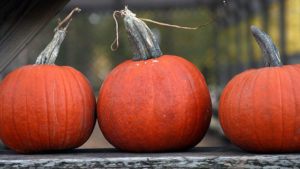Cornucopia’s Take: As garden harvests come in, few of us are thinking about weeding. But a few minutes spent pulling those invasive plants with ripening seeds can save hours next spring.
8 Gardening Mistakes You Make Every Fall
Rodale’s Organic Life
by Rebecca Straus
These autumn errors set you up for extra work come spring.
 |
Fall is probably the time of year when your garden begins to get away from you. You get lax about weeding and procrastinate cleanup as long as possible—sometimes until spring (guilty).
(Whether you’re starting your first garden or switching to organic, Rodale’s Basic Organic Gardening has all the answers and advice you need—get your copy today!)
But staying on top of things will make your job so much easier next season, and it can actually improve the health of your garden. Here are some common errors pro gardeners see people making in the fall and their advice for having the best autumn garden ever.
After a summer of diligently keeping the weeds down, you’re probably ready to throw in the trowel (see what we did there?) and leave them for cold weather and Mother Nature to beat into submission. But that’s a really bad idea, according to Mason Day, a life-long grower and co-founder of the social gardening app GrowIt. “Weeds often set their seeds in the fall months, so if you let your garden go this year, you’re going to be dealing with even more weed seedlings next spring,” he says. To make the chore easier, master the most effective way to remove weeds.
If you want tidy flower beds come spring, don’t forget to cut back dead foliage on your perennials. “Most perennial grasses grow back from the ground up,” Day says. “Sure, tall dead grass can provide a winter interest, but next spring it’s going to be hard to trim back the dead stuff when new shoots start popping up in between them.”
Pruning stimulates new growth, so cutting back branches in the fall causes your plant to put its energy into regrowing just when it should be conserving resources by going dormant for winter. This can severely weaken the plant, raising the risk that it won’t make it through the cold weather. Wait until late winter or early spring, when the plants are already dormant to make the cuts. This way they can begin the regrowth process just as they’re waking up from their winter slumber.
Don’t leave all your rotting plants and inedible veggies in place thinking you can just plow them under next year. Not only do they create an eyesore during the off-season, but they’re an open invitation for pests and diseases to ride out the winter in your garden. “Those leftover fruits can provide nutrients and refuge for diseases and insects that would love to visit your garden again next year,” Day says. “Cleaning up this fall could mean starting out with fewer bugs next season.”
If you want spring-blooming flowers like daffodils, tulips, and hyacinths, you need to think ahead and get the bulbs in the ground before the first hard frost. They need a long period of cold weather to initiate the biochemical process that causes them to bloom and time to develop roots.
If you planted perennials thinking it was a once-and-done effort, you may be a little disappointed to hear they do need some TLC in autumn. According to Day, most perennials need to be divided in fall to rejuvenate the plant and keep them blooming. “When perennials are left undivided, they can often develop rings or bald spots in the middle of a clump of plants,” he says.
Plus, dividing parent perennials into a bunch of babies means you can plant them in other areas of the garden. However, not all perennials need to be divided every year, and there are a handful that should never be divided. For more info, check out this handy chart from the Clemson University Cooperative Extension.
The leaves may have started to turn, but don’t hang up your gardening gloves just yet. There are plenty of crops that prefer cooler fall temperatures, Day says. For example, spinach, lettuce, kale, and radishes all do well in fall, and they have short growing seasons so they’ll mature before a fatal frost hits. “As a bonus, you can leave any spinach that you don’t harvest in the ground,” Day says. “It can overwinter during most years (depending on where you live), and this will give you a healthy spinach crop early next spring.”
Cover crops may be something you associate with a large-scale farming operation, but you should consider planting them in your home garden, too. They’re crops like clover and buckwheat that are intentionally planted to restore nutrients to the soil and suppress weeds. Plan to get them in the ground about four weeks before the first frost to give them a chance to mature.

